Silicate brick is considered an affordable and almost universal masonry building material, its scope is limited only to areas exposed to intense moisture and high temperatures. The manufacturing technology allows to produce products of any size and shape, including non-standard ones. But the three main groups are most in demand: single, thickened and double. The size does not determine the functional purpose, but only the type and method of dressing during laying, but this parameter directly affects the speed and efficiency of work.
Depending on the intended purpose, silicate brick is divided into:
- Ordinary - for ordinary masonry, with an unpainted rough surface, a slight presence of chips is allowed.
- Facing - decorative products with a smooth, textured or embossed surface with a wide colors. There are no spots or chips on the ribs.
Both groups, in turn, are divided into full and hollow, the second variety may have technical large holes or slots across the entire width (from 3 to 14). The standard density of the material is 1900 kg/m3, the need to reduce the weight on the foundation and floors is obvious. This design explains why the weight of sand-lime bricks of the same size can be different.
Hollow types are valued for good sound and heat insulation properties, but inferior in strength characteristics. Therefore, in load-bearing critical structures, only a full-bodied version is used. He wins in terms of saving the consumption of masonry mortar, for blocks with a voidage of up to 30% it takes at least a third more, and this cannot be avoided.
Material Features
Depending on the grade of strength (ability to resist external influences kg / cm2), the blocks are divided into:
- M75, M100 - recommended only for partitions.
- From M125 to M175 - for any one-story buildings, with the exception of foundation ones.
- M200 and M250 - used in the construction of load-bearing structures of multi-storey buildings.
The thermal conductivity of silicate blocks depends on the number of voids: from 0.68 W / m ° C - for hollow ones, to 0.77 - for solid ones. Frost resistance varies from 15 to 50 cycles.
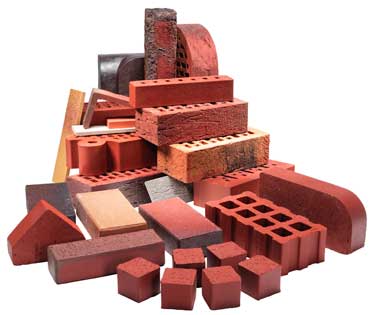
Basic geometric parameters
The concept of a standard size (1NF) refers to a single brick with a spoon surface length of 250 mm, a bonder surface of 120 and a thickness of 65. Such products are considered optimal for the construction of self-supporting walls. All cladding marks in one way or another have values that are multiples of 120 or 250 mm. The minimum weight is 2.1 kg, the maximum corpulent - 3.6.
In practice, there is often a need to use bars bigger size, the most popular variety is considered to be silicate one and a half. According to GOST, its format is designated 1.4 NF, the length and width remain unchanged, in contrast to the height - 88 mm. The second name of such products is thickened brick, the scope is determined by the voidness and surface quality. The minimum weight of 1 piece should be 3.9 kg, the maximum - 5, but there are also lighter options on sale with a percentage of gaps above the permissible norm.
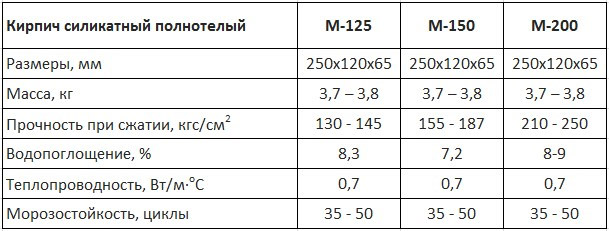
The size of a double product (2.1 NF) is 250 × 120 × 138 mm (exactly like two standard ones folded together). It is used when it is necessary to speed up the masonry process, facing varieties are less common. Working with the material is not as convenient as you might think: the minimum weight of the blocks is 6.7 kg, the maximum is 7.7.
Permissible deviations from the standard dimensions of silicate bricks are no more than ± 5 mm in length, 4 in width, 3 in height. Marriage should not be confused with the less common Euro blocks (0.7NF) or other single modules. Non-standard options are rarely used for the construction of buildings, they are advised to buy for masonry architectural elements: arches, vaults, partitions or cladding. The most popular brand in private construction is one and a half with a strength of M150.
Estimated cost of material
| Name | Color | Manufacturer | Weight, kg | Strength grade | Water absorption | Price for 1 piece, rubles |
| Facing solid one-and-a-half brick smooth | white | Kovrovskiy ZSK | 5 | M200 | 10 % | 13,8 |
| black | 15,7 | |||||
| Facial full-bodied single | grey | Porevit | 3,4 | M175 | 16% | 11,1 |
| Construction hollow one and a half | unpainted | Simat | 3,7 | 13 % | 11 | |
| ISSS | 3,85 | 12,5 % | 11,2 |
In the modern construction market, there are a huge number of different materials, each of which has its own unique characteristics. Sand-lime brick is one of the most popular materials for facade and building cladding. The size of the white silicate brick, as well as some of its other parameters, may vary. Before purchasing this material for construction, it is worth familiarizing yourself with its features in more detail.
Types of silicate white brick
Before asking the question - how much does silicate white brick cost, you need to understand that this is a very loose concept. There are several options for classifying this type of brick:
- in size - standard and one and a half bricks. The parameters of the standard - 250x120x65 mm, one and a half - 250x120x80 mm. It is also possible to produce silicate bricks not standard size if required by the customer. The size of the white silicate brick depends only on what kind of masonry you plan to do;
 The dimensions of a standard silicate brick and the names of its sides: 1 - spoon, 2 - poke, 3 - upper bed, 4 - lower bed, 5 - vertical rib, 6 - horizontal transverse rib, 7 - horizontal longitudinal rib
The dimensions of a standard silicate brick and the names of its sides: 1 - spoon, 2 - poke, 3 - upper bed, 4 - lower bed, 5 - vertical rib, 6 - horizontal transverse rib, 7 - horizontal longitudinal rib
- in shape - hollow or full-bodied. In the first variant, there are round or rectangular recesses in the brick, which are located perpendicular to the widest face of the product. If it is important for you how much silicate white bricks weigh, then it is better to choose the hollow option. By the way, it can be two-hollow and three-hollow. Solid silicate brick has a monolithic fill and, accordingly, weighs more;
- by scope - facing bricks and bricks for special purposes. It is logical that the first option is used for the purpose of facing facades, but the second is used to create fireplaces, stoves, build ceilings, foundations and other structural elements.
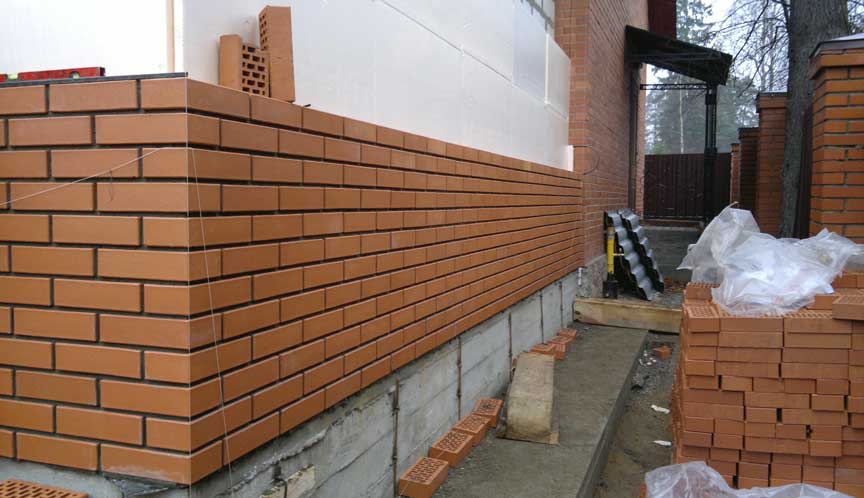
When choosing the size of white silicate brick and its other characteristics, consider, first of all, the scope of the material. For example, for finishing the facade of a house better fit hollow facing brick. Monolithic brick is often used for foundations, as it is able to withstand heavy loads.
The main characteristics of silicate brick
Many mistakenly believe that a brick is a very simple product. In fact, even this building material has a lot of features. Before you find out the price per piece of white silicate brick, pay attention to the following performance characteristics:
- the presence of increased frost resistance - this parameter is useful if you plan to build a house in a cold winter or simply sudden changes in temperature;
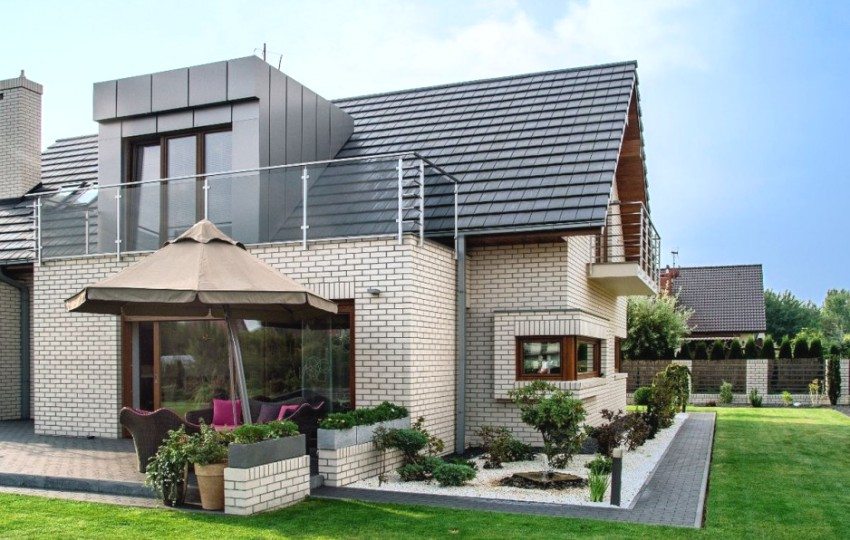
- the weight of silicate white bricks - a hollow brick weighs a little more than 3 kg, one and a half - 4 kg, standard solid - 3.5 kg, solid one and a half - almost 5 kg;
- waterproofing properties of the material - as a rule, high-quality silicate white brick does not allow water to pass through, so it can be safely used for external finishing works without fear that the facade will lose its attractive appearance because of the rain.
Useful advice! As for the use of silicate brick for a stove or fireplace, then you will have to act at your own peril and risk. Brick has a sufficiently high thermal conductivity, so structures made of it can become unusable relatively quickly.
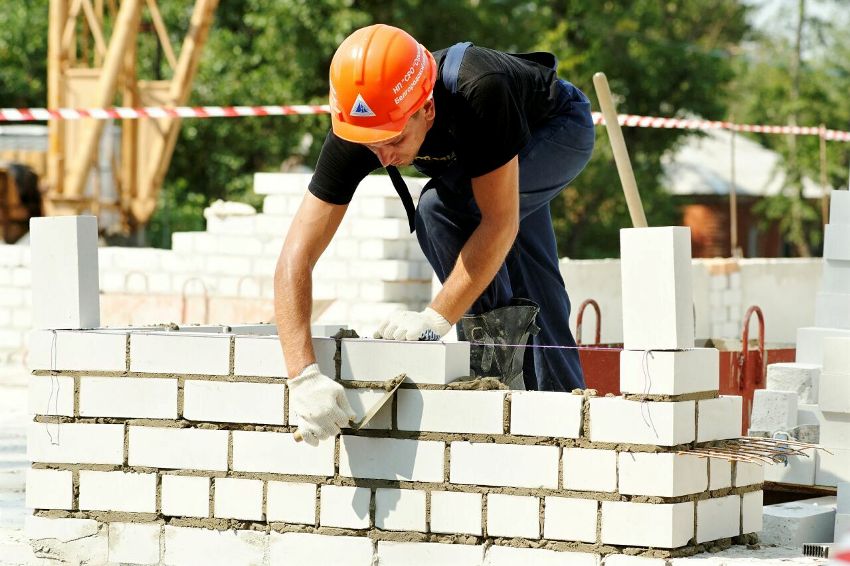
How does the size of white silicate brick affect the finishing features
Whatever size of white silicate brick you choose, you should always take into account a number of nuances when laying:
- The seam between the bricks should not be more than 1.3 cm.
- Between the masonry and the wall itself, be sure to leave a small space for ventilation, this will help you avoid the accumulation of condensation on the bricks.
- Silicate absorbs moisture well, so brick mortar should be made thick.
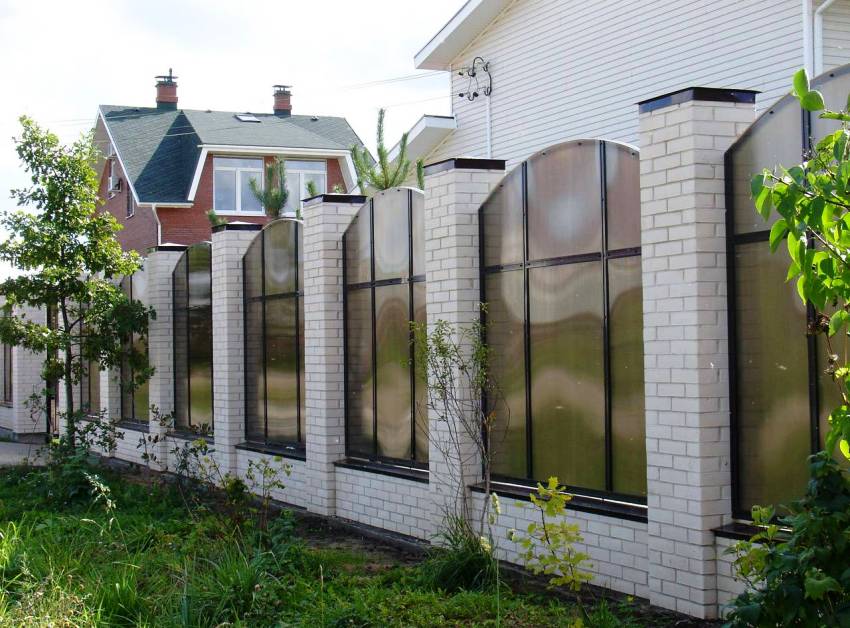
If you do not want your silicate brick walls to suffer from moisture and lose their performance properties, then it is recommended to cover fresh masonry with special moisture-resistant solutions.
The rest of the laying of silicate white brick- it's pretty simple. You can handle this on your own even with minimal building skills.
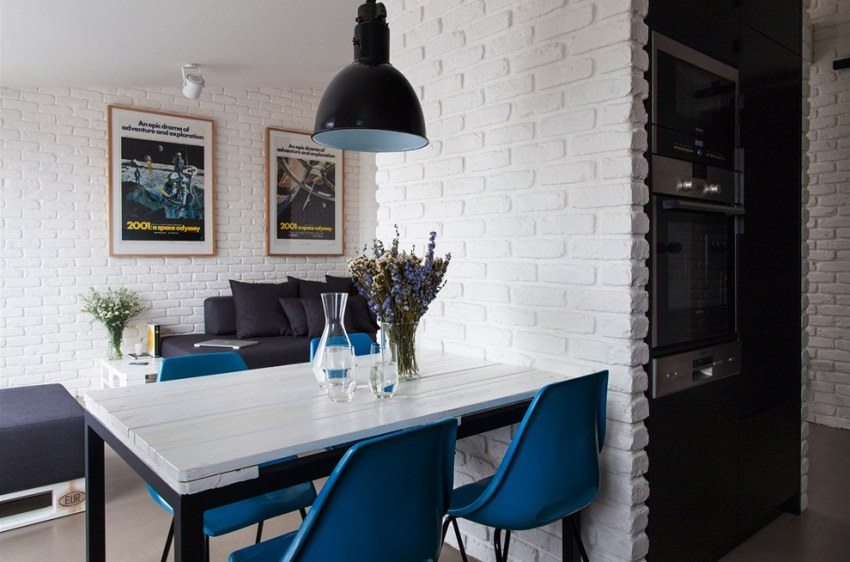
Advantages and disadvantages of silicate white brick
It is not for nothing that white silicate-based bricks are very popular among builders. Among its advantages are the following:
- reliability and durability;
- frost resistance, resistance to temperature extremes and other adverse factors of a natural nature;
- a large selection of color options;
- unpretentiousness and simplicity in installation and operation.
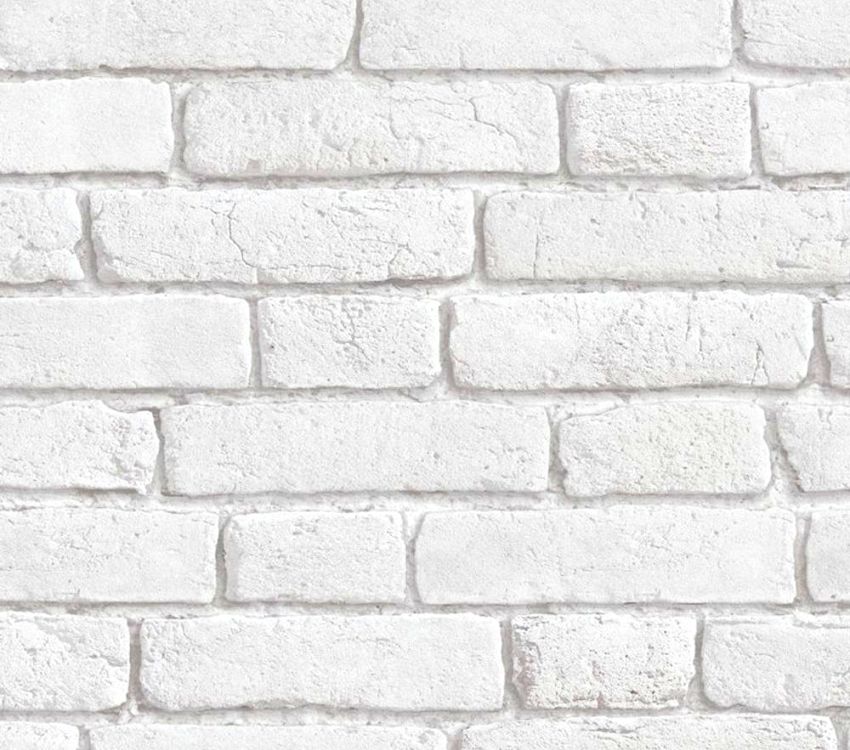
Also silicate brick provides in the house high level thermal insulation, resistant to mechanical stress. The disadvantages include a low level of heat resistance, which can be quite problematic to use such a brick for the construction of stoves and fireplaces.
Useful advice! When facing the facade, it is best to use hollow bricks of standard sizes. This will allow you not only to save on material, but also to end up with a fairly lightweight design.
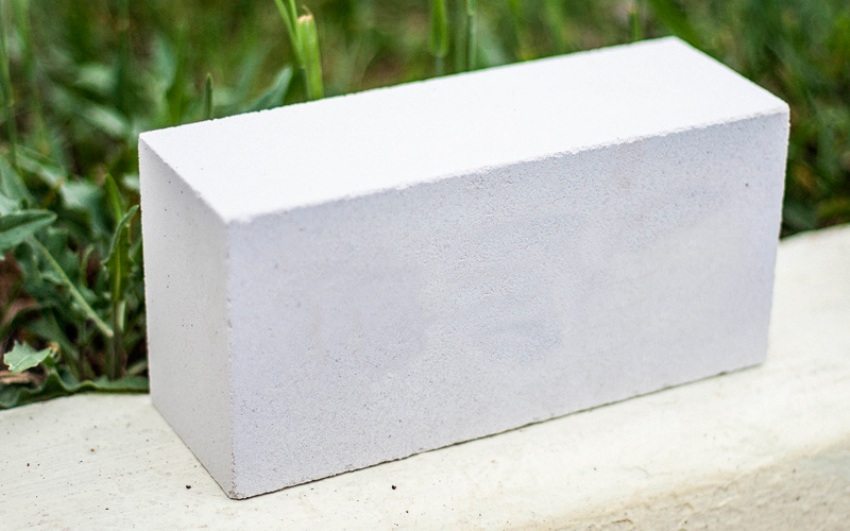
The price of silicate white bricks is not too high compared to other building materials. This allows you to widely use them and at the same time not spend too much financially. That is why many builders choose white sand-lime brick as a building material for exterior and internal works. And its relatively low weight, combined with excellent performance characteristics, make brick very popular for the construction of a wide range of buildings.
One and a half brick - in demand construction material, which is valued for durability, low weight and ease of masonry. It has a regular geometric shape and a standard size of 250×120×88 mm, which is 1.4 of the usual format. Larger dimensions provide better insulating properties, reduce the amount of cement, labor costs and overall construction time. At the same time, the cost of masonry, taking into account the consumption rate, is 1 m3 lower than when using standard bricks.
Depending on the raw material, ceramic (red) and silicate (white) bricks are distinguished. The first type is made from various types of clay and is used in the construction of walls, lintels, plinth masonry, pipes and furnaces. The surface of such products is usually corrugated, which facilitates the process of applying plaster. For external finishing work, it is worth buying a one-and-a-half facing brick, produced according to special technology from refractory raw materials. Disadvantages: high price and possible efflorescence.
Silicate is a mixture of lime and sand, one and a half blanks are obtained from it by autoclave synthesis: semi-dry pressing to achieve the desired size and subsequent treatment with water vapor, at significant pressure and temperature. Bottom line: environmentally friendly and cheaper, compared to ceramics, dense building material with good sound insulation. To create a colored product, alkaline additives are introduced, which allows expanding the range and using it for facade cladding. Such a coating is resistant to external influences, but has significant drawbacks: low moisture resistance and heat resistance, which limit the scope of application (one and a half silicate bricks are not suitable for laying foundations or wells, as well as furnaces). But when building internal partitions and inter-apartment walls and pillars, filling voids, it is indispensable.
According to the manufacturing method, they distinguish: solid (solid) and hollow (slotted or porous) brick. One-piece is used in ordinary construction, facing is most often made with voids. Porization reduces the consumption of raw materials, the weight of one and a half products and the load on the foundation. In addition, the presence of voids (up to 70%) has a positive effect on the thermal insulation properties. But slotted bricks cannot be used for laying foundations and load-bearing walls.
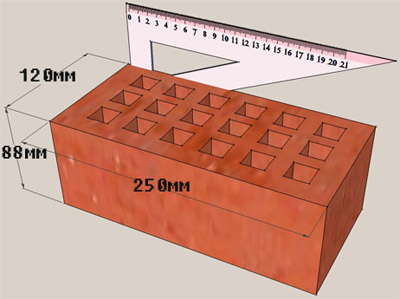
Main characteristics
Trademarks used: 76, 100, 125, 150, 250, 200 and 300 indicate the allowable compressive pressure (kg/cm2). Strength is judged by marking, but this is not the only indicator. The characteristics of one and a half bricks include:
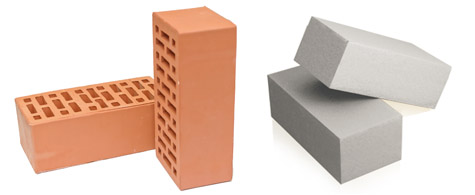
What should be taken into account when installing?
When choosing, you should pay attention to the quality and passport characteristics, purchase products of the same size and color, without cracks, punctures or stains. A preliminary calculation of the required material is necessarily carried out, taking into account the consumption rate and 10% for the stock ( total area walls, minus openings, is multiplied by the amount of 1 m2 of masonry, for a one-and-a-half brick, this value is 41). The size is standard, but it is better to double-check the manufacturer's data. The next stage is the preparation of a solution of cement, sand and water, in a ratio of 1:4:6, with a small addition of lime for plasticity. The mixture must be sufficiently viscous, especially when using slotted bricks, and all components are thoroughly mixed: for bulk work, you need to buy or rent a concrete mixer.
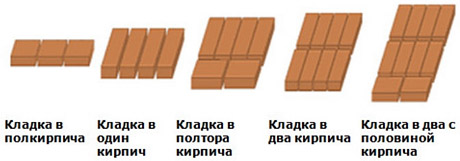
During the laying process, the evenness of corners and rows is monitored, deviations from straight lines are unacceptable. A long profile or a taut cord is used, a building level; the first horizontal is carefully checked. The corners are erected first, just above the walls, the straightness of the laying of one and a half products is ensured by ordering (a metal rail with divisions), then leveling beacons are installed along them. The solution is distributed evenly, without excess, the optimal thickness of the seam horizontally is no more than 12 mm, vertically - 10. Jointing is carried out if subsequent plastering of the facade is not planned. Otherwise, the masonry is led into a wasteland, in which the solution does not reach the front side by 10–15 mm.

Be sure to carry out:
- Ligation of bricks.
- The use of a reinforcing rectangular mesh at least every five rows.
- Wetting products before work.
- Removal of excess solution that has not yet solidified.
- Grinding corners.
average cost
| Strength grade | Weight, kg | Price for 1 piece, rubles | |
|
Brick one and a half silicate |
|||
| full-bodied | 150 | 5 | 11 |
| three-hollow | 200 | 3,8 | 10 |
| decorative | 150 | 5 | 12 |
|
One and a half ceramic |
|||
| full-bodied worker | 150 | 4 | 18 |
| construction hollow corrugated | 125 | 3,4 | 11 |
| facing slotted | 150 | 3,2 | 14 |
| 3,4 | 18 | ||
| 200 | 3,5 | 24 | |
The cost is determined by the weight, quality characteristics and decorativeness of products, ceramics are valued for their natural terracotta colors. Facing silicate brick is most often pink or light yellow. Glazed clay saturated and bright colors are much more expensive, the price reaches 200 rubles per 1 piece. It is important to monitor the tone of facial blanks, it is recommended to immediately buy the required amount.
Artificial stone, which has a rectangular shape and is used in construction - brick, an assistant of our time.
Help from history
Brick is such a familiar building material in our lives. In the form in which it is now, this material appeared in the sixteenth century in England. Before that, building materials of this kind were used in Egypt, long before our era, in ancient Rome, in Mesopotamia. These could be clay plates - plinths, which were made in wooden molds and fired in a kiln. Clay and straw plates were also made, but such bricks were not fired. In Rome, they used rectangular clay products measuring 450/300/100 mm (for comparison: the dimensions of a modern one-and-a-half brick are 250x120x88), which could be cut into triangular bricks (6 or 8 pieces were obtained from one, if cut radially). They also made round bricks. But modern form For more than five centuries, it has been proving its convenience and practicality in use.
Possible sizes of modern brick
By linear dimensions, building materials are divided into three types:
Single;
one and a half;
Double.
The fourth type is also gradually entering - eurobrick, it is slightly smaller in width compared to a single one.
What is characteristic: the increase in mass is disproportionate to the increase in size. And the increase in size does not occur exactly one and a half, two times. The dimensions of a one-and-a-half brick and a single one differ in 23 millimeters of thickness, and in terms of weight they are almost the same (if full-bodied). By the way, bricks can be full-bodied and hollow - lightened due to voids, which occupy no more than 13% of the volume. Why was the hollow version invented? Naturally, to reduce weight.
Red brick and silicate brick are made from different materials, but their dimensions are identical.
Features of red brick
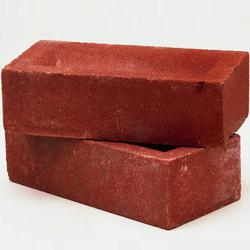
Many houses throughout the post-Soviet space, garages and other structures were made from it. There are two main types. One of them is very heat-resistant - it easily withstands temperatures of 1.4-1.8 thousand degrees. The other is made more “responsive” to heat transfer in order to use it in the construction of stoves, fireplaces, the task of which is to heat certain room. Production material - clay. The following ratios of length / width / thickness are characteristic of red brick:
Single brick dimensions: 250x120x65 mm;
Dimensions of one and a half bricks: 250x120x88 mm;
Double: 250x120x138mm (more than double the thickness).
The size of a one-and-a-half red brick is increased only in thickness by 35 percent, therefore the second name is thickened.
For the European standard - the width of the product is thirty percent less, the dimensions are 250x85x65 mm.
They also vary in weight, depending on whether they are full or hollow.
Single: full-bodied - about 3.6 kg, hollow - 2.3 kg or about 2.7 kg;
One and a half: full-bodied - about 3.7 kg, hollow - 3.1 kg;
Double: full-bodied - about 4.2 kg, hollow - 2.2 kg.
Features of silicate brick
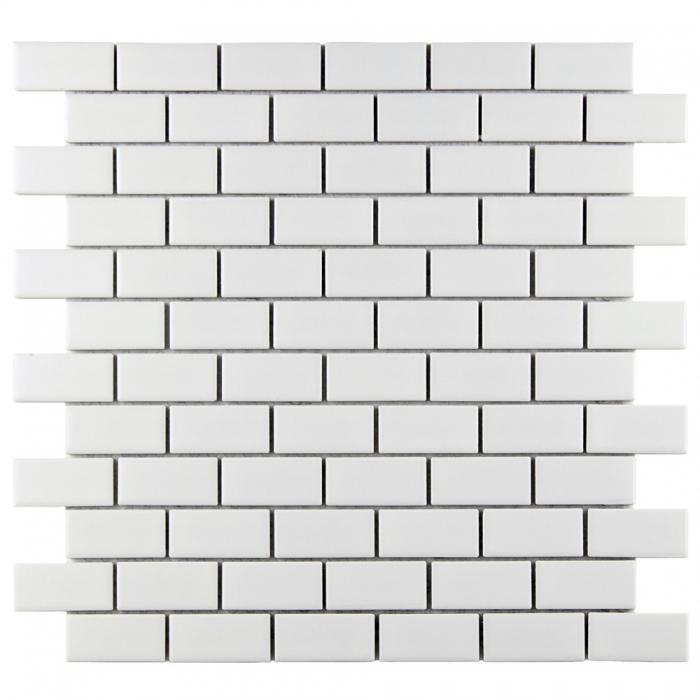
White silicate brick is made in the proportion of 9 parts lime - 1 part sand. In addition to them, a small amount of impurities can be added. The properties of white bricks are not the same as red ones, for the obvious reason - different materials of manufacture. Silicate has a much lower water and fire resistance, lower chemical and frost resistance. But its density and thermal conductivity are much higher, and the manufacturing time is also considered a plus. Red brick needs up to six days, while white brick needs from 15 to 18 hours. The size of the one-and-a-half, double and single silicate brick is similar to the size of the red one, the difference is only in weight.
Single dimensions: 250x120x65 mm; weight: full-bodied - 3.6 kg;
Dimensions of one and a half bricks: 250x120x88 mm; weight: full-bodied - 4.9 kg, hollow - 4.3 kg;
Double brick: 250x120x138mm; weight: full-bodied - 7.7 kg, hollow - 6.7 kg.
A long time ago, various natural materials, including stone, were used to build buildings. AT modern world, stone is sometimes used in construction, but buildings from it are expensive. Brick has become a good alternative, it is a more durable material for construction. Bricks are made according to certain standards. There are more than 15 thousand color and texture compounds.
The universal sizes of a brick allow to use in different variations. Before starting work with a brick, it is necessary to study its types, sizes and types.
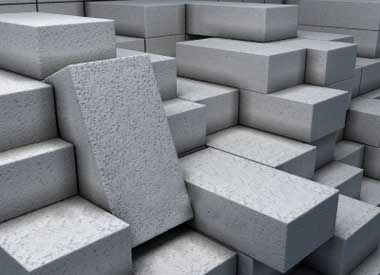
Raw materials for making bricks
Used to be bricks
made from clay, which was subsequently fired in kilns. Over time, the recipe for making bricks changed, various ingredients were added to the composition, such as straw, the drying time and the volume of water were increased. Fired blanks (plinths) have high strength, so they are used for the construction of tall buildings.
In modern brick production, clay is also used, sand, lime and various additives are also used.
There are two different types bricks:
 Silicate. For the manufacture of such bricks, sand, lime and binders are used in small quantities. The brick has a gray-white color. In production, the brick is doused with high-pressure steam. The disadvantages of silicate bricks are not fire resistance and moisture resistance, so it is used in the construction of walls and partitions indoors.
Silicate. For the manufacture of such bricks, sand, lime and binders are used in small quantities. The brick has a gray-white color. In production, the brick is doused with high-pressure steam. The disadvantages of silicate bricks are not fire resistance and moisture resistance, so it is used in the construction of walls and partitions indoors.
Ceramic or red. It is produced from almost one clay, the number of additives is not large. The blocks are fired. Such a brick is not whimsical, in use and can withstand up to 1.8 thousand degrees of heat.
Red brick is of two types:
Refractory. This type of brick is made from more resistant clay, it differs in the type of hardening. Such a brick is heat-resistant, suitable for buildings where high temperatures are used.
 Simple. Not afraid of temperature changes, they use such a brick during construction.
Simple. Not afraid of temperature changes, they use such a brick during construction.
The blocks have voids, due to the porous structure, heat is retained, and the weight of the structure becomes less. From the method of application, bricks are divided into simple(for building walls and partitions) and facing(for decoration).
Initially, bricks were made by hand, and there was no talk of any technologies and norms. At the beginning of the 20th century, the situation changed, as bricks began to be produced in factories. Each plant set certain standards for its products, so the construction of facilities progressed slowly. The situation was changed by Peter I, he gave the order to make bricks according to one standard, but such a brick turned out to be very cumbersome and not convenient for construction.
Types of brick sizes
Uniform state standards for the production of bricks were introduced in 1927, and they are still used today.
There are main requirements for the manufacture of bricks:
 A standard (single) brick is made with dimensions of 120x250x65 mm.
A standard (single) brick is made with dimensions of 120x250x65 mm.
This size is the best option for construction, if you need to alternate between transverse and longitudinal masonry. A single block has a size that is considered normal for NF.
Red brick or one and a half silicate has dimensions of 120x250x88 mm. Designated as 1.4 NF. Such a brick is used in the construction of walls, it is more convenient to use and 378 pieces are used per 1 m3 of masonry, and 512 single bricks. This brick has several subspecies:
- Porous;
- Hollow;
- Perforated and so on.
2.1 NF or double with dimensions 250x120x103 mm. Used to speed up construction.
The name should not affect the size of the brick, and this is established by GOST.
The parameters for facing bricks must match those of conventional bricks.
In the manufacture of products, as a rule, shrinkage occurs, according to the norms, a slight deviation is quite possible: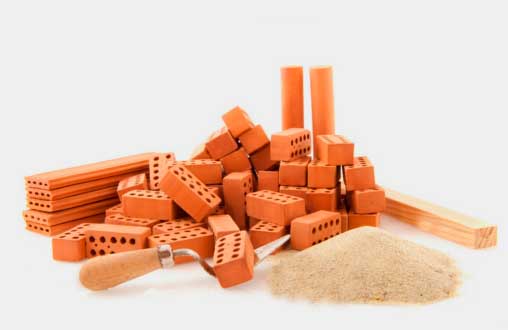
- Length approximately 4 mm;
- Height is not more than 3 mm;
- Width 3 mm and no more.
In addition to double, one-and-a-half and single standard bricks, bricks are also made in the size of 250x120x138 mm, they are commensurate with two layings of ordinary bricks.
Sometimes blocks are taken instead of bricks, they are released from lightweight concrete with cells. The second option is concrete with expanded clay filling. Such blocks have a size of 390x190x188 mm. It will give a beautiful, finished look to the building; there are no certain standards for its size.
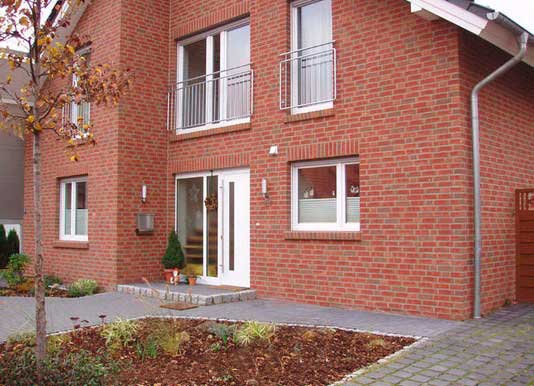 Hollow brick is one of the more popular materials, it has an excellent appearance and due to this material, the walls resist frost better and retain heat.
Hollow brick is one of the more popular materials, it has an excellent appearance and due to this material, the walls resist frost better and retain heat.
Facing bricks of standard size 120x250x65, they are highly demanded, euro-bricks are also often in demand, their dimensions are 250x85x65 mm, such blocks are light in weight, economical and fast in laying.
Bricks with relief, figured surface and roundings have a variety of sizes, but with ordinary bricks they are suitable only in length.
Silicate brick size
Refractory fireclay bricks have non-standard dimensions of 230x113x65 or 230x123x65 mm. 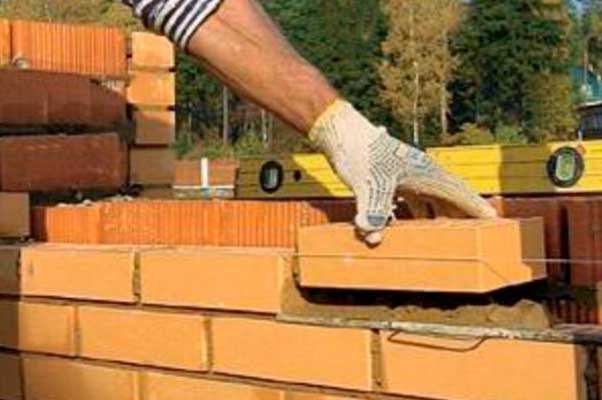
Silicate bricks were produced much later than red bricks; they are produced by autoclave synthesis. In the production of silicate bricks, sand, lime are used, these components are mixed and pressed into bricks. In order for the brick to have a color, and special properties, dyes are added to the composition. The formed blocks are placed in an autoclave, where the blocks are doused with high-pressure steam.
Silicate bricks come in three varieties:
- Single. Standard, not often used (250x120x65 mm), euro version, its width is smaller and is 85mm;
- One and a half (250x120x88 mm);
- Double (250x120x138 mm).
In construction, a double or one and a half type of block is more often used. Silicate brick of any size, it can be hollow or solid, their weight differs by about 1 kg.
In a hollow brick, holes can be through and perpendicular to the bed. Depending on the material, the weight of silicate or standard bricks is approximately 4 kg. Due to the cavities in the hollow brick, its weight becomes less.
In blocks, voids can be of different shapes and sizes, for this reason, the weight of a brick must be measured individually.
Facing bricks are produced with a smooth beautiful surface especially for exterior finishing work and to protect walls from snow and rain. To create unique and original buildings, they produce bricks with different colors.
Facing brick happens:
- Clinker. It is made from the best materials which have high attractiveness and durability.
- Ceramic. It happens with and without voids. From hollow blocks, the structure turns out to be lighter, structures from solid bricks turn out to be heavier and more durable.
Clinker bricks are used to finish doorways, windows, plinths, garden paths, etc., as it has special strength and frost resistance.
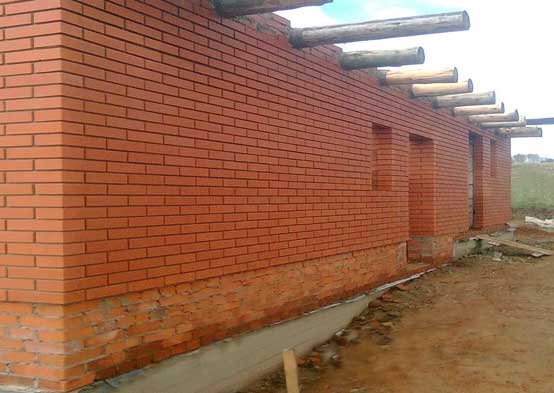 A hyper-pressed block is made from limestone and cement by pressing, such a brick has chips and is used in decorating a building. The brick looks like a natural stone, resistant to low temperature and wear-resistant. The downside of this material is its high density.
A hyper-pressed block is made from limestone and cement by pressing, such a brick has chips and is used in decorating a building. The brick looks like a natural stone, resistant to low temperature and wear-resistant. The downside of this material is its high density.
Facing, silicate brick has good qualities and budget price. Such a brick is used in private houses.
A single silicate brick is produced with dimensions of 65x120x250 mm, one and a half 88x120x250 mm, sometimes a double one is used and its dimensions are 138x120x250 mm, it is possible to buy bricks of non-standard sizes.
Facing ceramic blocks can be smooth, matte, with imitation of various materials and textured surface. ceramic brick self made on the this moment is popular, it is produced only in European countries and has a high price. the facing block has standard dimensions.
The introduction of norms for the manufacture of bricks facilitated construction work, the blocks became convenient to use. But in our time, changes in the standards of brick production are possible.




















